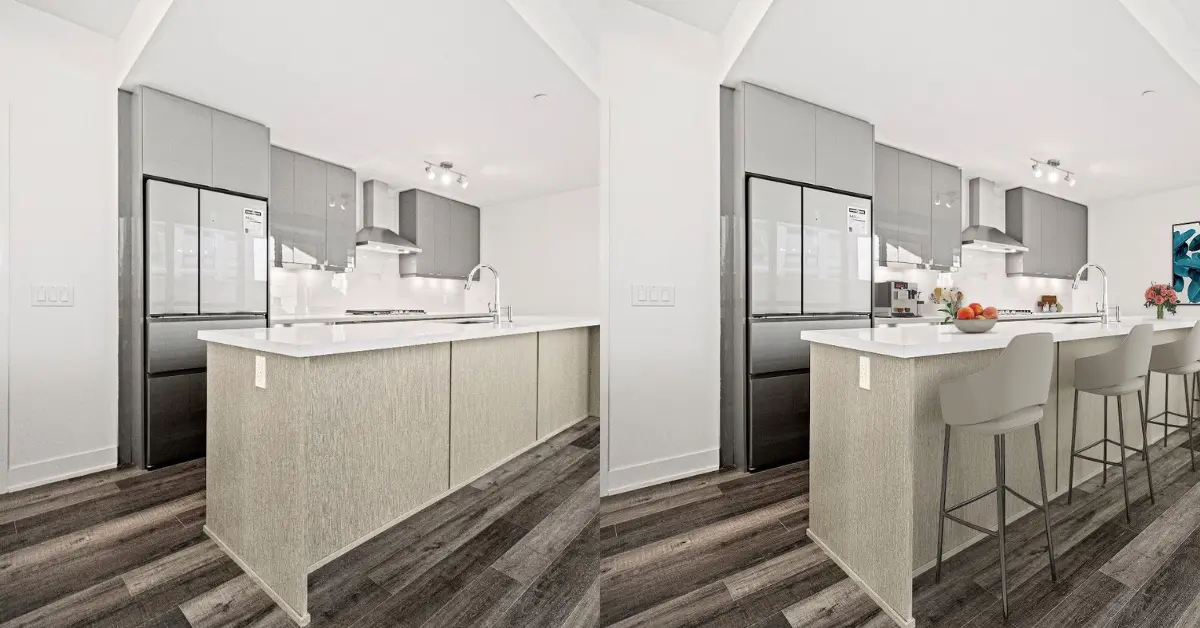In today’s competitive real estate market, where buyers are quick to move on from unappealing listings, presenting a home in its best light can make all the difference. Virtual staging has emerged as a revolutionary tool that brings out the potential of a property, showing buyers how each space can function and feel once furnished. Whether you’re a real estate agent, a private seller, or a business owner with a commercial space, virtual staging can be a cost-effective and powerful way to engage potential buyers.
This guide will break down the benefits of virtual staging, explore how it works, and show how it can help you stand out in a crowded market.
1. What Is Virtual Staging?
Virtual staging is a 3D technology that digitally adds furniture, decor, and style to photos of empty rooms. Unlike traditional staging, which involves physically renting and placing furniture, virtual staging achieves similar results digitally—and often at a fraction of the cost and time. It’s an ideal solution for properties that are either vacant or lack visual appeal, as it helps buyers envision the full potential of a space.
2. Benefits of Virtual Staging
Virtual staging offers several advantages for sellers, real estate agents, and commercial property owners. Let’s explore these benefits in depth:
a) Cost-Effective Solution
Traditional staging can be an expensive and labor-intensive process. Depending on the size of the property and the duration of the listing, staging can cost thousands of dollars. Virtual staging, however, is typically 30-40 times less expensive than traditional staging. With virtual staging, you only pay for the digital transformation of your photos, making it a budget-friendly alternative that yields impressive results.
b) Faster Market Readiness
Traditional staging can take several weeks to complete, factoring in consultations with designers, sourcing of furniture, and physical setup. Virtual staging, by contrast, can be completed in as little as 24 hours. This rapid turnaround allows you to list the property almost immediately, reducing time-to-market and maximizing exposure for buyers actively searching.
c) Enhances Buyer Engagement
According to the National Association of Realtors, 90% of homebuyers begin their search online and rely heavily on photos to determine which properties to view in person. A vacant home often appears cold and impersonal in photos, making it difficult for buyers to imagine the layout or potential. Virtual staging fills in this gap, enabling buyers to see a furnished, welcoming space that emphasizes the property’s strengths and inspires a sense of possibility.
d) Leverages Design Trends to Attract Buyers
Virtual staging companies use professional designers who stay on top of the latest decor trends. This means the staged images will reflect current tastes, creating an appealing, up-to-date look that resonates with buyers. The ability to customize designs to match architectural styles ensures that the staging is not only attractive but also harmonious with the property’s unique characteristics.
e) Strengthens Buyers’ Recall of the Property
After an in-person viewing, buyers often review photos to recall specific details of the home. If the listing photos are staged to look like the actual space, it helps reinforce the buyer’s memory, making it easier for them to visualize themselves living there. Memorable staging can be a deciding factor, particularly when buyers are considering multiple properties.
3. Who Benefits from Virtual Staging?
Virtual staging is versatile, making it useful for a wide range of sellers and property types:
- Private Home Sellers: Those selling vacant homes can use virtual staging to highlight room layouts and decorative potential, helping them compete in the market.
- Real Estate Agents: Agents often use virtual staging to make listings stand out, particularly in competitive areas where many homes may look similar.
- Apartment and Condo Owners: Rental properties can be virtually staged to showcase different layout and furniture options, helping tenants visualize their living spaces before leasing.
- Hotels: Hotels can use virtual staging to display different room designs, creating the best possible online impression and showing variety for potential guests.
- Office Spaces: Virtual staging is also ideal for commercial spaces, enabling office owners and leasing agents to showcase flexible work areas, meeting spaces, and breakout rooms.
4. The Psychology Behind Virtual Staging: Why It Works
Virtual staging is more than just adding digital furniture—it’s a strategic move rooted in psychology. The power of virtual staging lies in its ability to create an emotional connection with potential buyers. Here’s why it works:
a) Visualizing Functionality
Empty rooms can feel abstract and unwelcoming. Virtual staging helps potential buyers picture how the space could function in real life, showing them everything from the coziness of a living room to the practicality of a home office. This functional visualization makes the listing feel like a “real home” rather than just an empty house.
b) Inspiring Personal Connection
When buyers see tastefully staged rooms, they begin to imagine themselves living there. Thoughtfully chosen decor and furniture create a sense of warmth and comfort, sparking a personal connection with the space. Buyers who feel connected to a property are more likely to follow through with a purchase.
c) Highlighting Room Dimensions and Flow
Staging also clarifies the size and layout of a room, which can be difficult to gauge in an empty photo. Adding furniture helps buyers understand spatial relationships and envision how they might arrange the space. Virtual staging can emphasize open floor plans or guide the eye to unique architectural details, making each room feel cohesive and inviting.
5. The Virtual Staging Process
If you’re new to virtual staging, here’s a step-by-step guide to get you started:
a) Clean and Photograph the Property
A clean, clutter-free environment is essential for high-quality virtual staging. Tidy up, remove any distracting items, and ensure that natural light fills each room for bright, attractive photos.
b) Hire a Professional Photographer
Clear, well-lit photos are crucial for successful virtual staging. Hiring a professional photographer ensures that you get high-resolution images that highlight the property’s best features. Good photography maximizes the impact of virtual staging and makes the images look realistic and appealing.
c) Choose a Virtual Staging Company
Once you have your photos, choose a virtual staging provider with a portfolio that matches your desired style. Look for a company that offers a variety of staging options, such as modern, traditional, or eclectic, to suit different property types and buyer preferences.
d) Select Room Designs and Furnishing Styles
Work with the staging company to decide on the design for each room. Some sellers may prefer a cohesive, uniform look, while others might want to differentiate each room with unique decor to highlight specific features.
e) Review and Approve the Final Images
After the staging is complete, review the images to ensure they align with your vision. Most companies allow a few rounds of revisions, so don’t hesitate to request adjustments if the staging doesn’t meet your expectations.
For a deeper understanding of how recent interest rate cuts are impacting Canadian home sales, check out this comprehensive analysis on preconstruction.info.
6. Virtual Staging Best Practices for Success
To make the most of virtual staging, keep these best practices in mind:
a) Be Transparent with Buyers
Although virtual staging is incredibly realistic, it’s important to be transparent about its use. Labeling the photos as “virtually staged” ensures that buyers know the images are digitally enhanced, helping to manage expectations.
b) Use Staging to Emphasize Key Features
Virtual staging can be used strategically to highlight key features, such as a spacious living room, a cozy reading nook, or a functional home office. Make sure the staging design complements each room’s unique characteristics.
c) Avoid Overly Trendy Decor
While staying current is important, avoid decor that might be too trendy or niche. Aim for timeless designs that have broad appeal and are likely to resonate with a wide audience.
d) Keep the Design Consistent
Maintaining a consistent design style throughout the home creates a cohesive flow that’s visually appealing. This uniformity helps reinforce the buyer’s vision of a harmonious living space, making the property feel more like a home.
7. Is Virtual Staging Worth It?
For many sellers, the answer is a resounding yes. Virtual staging is an effective, affordable solution that enhances a property’s appeal without the logistical and financial burdens of traditional staging. With the ability to make properties market-ready in less than 24 hours, virtual staging is perfect for today’s fast-paced real estate environment.
For a deeper understanding of how recent interest rate cuts are impacting Canadian home sales, check out this comprehensive analysis on preconstruction.info.
Final Thoughts
Virtual staging is not only about decorating a property—it’s a powerful tool that taps into buyers’ emotions and imagination. With virtual staging, you’re not just showcasing a property; you’re offering a lifestyle, presenting buyers with a vision of what their lives could look like within the space.
From its cost-effectiveness to its ability to engage and inspire buyers, virtual staging has transformed real estate marketing. By creating a visual story that resonates with potential buyers, you’re well on your way to standing out in the competitive real estate market and securing top-dollar offers for your property.
To complement your virtual staging efforts, collaborate with custom home builders in Toronto for expertly designed spaces that attract buyers.
Enhance your virtual staging images with high-quality photography from Click Media Pro, ensuring every detail shines for potential buyers.

